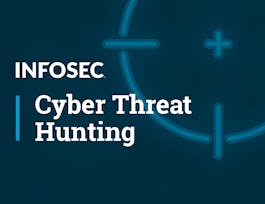The course "Advanced Malware and Network Anomaly Detection" equips learners with essential skills to combat advanced cybersecurity threats using artificial intelligence. This course takes a hands-on approach, guiding students through the intricacies of malware detection and network anomaly identification. In the first two modules, you will gain foundational knowledge about various types of malware and advanced detection techniques, including supervised and unsupervised learning methods. The subsequent modules shift focus to network security, where you’ll explore anomaly detection algorithms and their application using real-world botnet data.



Advanced Malware and Network Anomaly Detection
This course is part of AI for Cybersecurity Specialization

Instructor: Lanier Watkins
Sponsored by Louisiana Workforce Commission
Recommended experience
What you'll learn
Understand various types of malware and apply foundational analysis techniques to effectively detect and classify them.
Implement advanced machine learning algorithms, including clustering and decision trees, for efficient malware detection.
Explore anomaly detection techniques using botnet data and learn how to analyze network traffic for unusual patterns.
Collaborate and present research findings on current trends in network anomaly detection, enhancing communication and analytical skills.
Details to know

Add to your LinkedIn profile
9 assignments
September 2024
See how employees at top companies are mastering in-demand skills

Build your subject-matter expertise
- Learn new concepts from industry experts
- Gain a foundational understanding of a subject or tool
- Develop job-relevant skills with hands-on projects
- Earn a shareable career certificate


Earn a career certificate
Add this credential to your LinkedIn profile, resume, or CV
Share it on social media and in your performance review

There are 4 modules in this course
This course provides a comprehensive exploration of malware detection and analysis, covering the identification and classification of malware types and their characteristics. Students will learn fundamental concepts of malware analysis, network threats, and detection methods while employing various tools and algorithms for effective detection and performance assessment.
What's included
2 readings
In this module, we will discuss common types of malware, malware analysis tools, and basic malware analysis processes. Specifically, we will be discussing basic approaches to analyzing Windows-based malware.
What's included
2 videos3 readings3 assignments
In this module, we investigate hands-on malware detection implementations, both unsupervised and supervised. Also, we discuss metrics to evaluate the performance of malware detection algorithms.
What's included
2 videos3 readings3 assignments1 ungraded lab
This module will discuss the background of network threats and anomaly detection. Also, we explore hands-on implementations of anomaly detection analytics using botnet data and the next evolution of anomaly detection, autonomic cybersecurity systems.
What's included
2 videos4 readings3 assignments1 ungraded lab
Instructor

Offered by
Why people choose Coursera for their career




Recommended if you're interested in Information Technology

Johns Hopkins University

Edureka

University of London

Infosec

Open new doors with Coursera Plus
Unlimited access to 10,000+ world-class courses, hands-on projects, and job-ready certificate programs - all included in your subscription
Advance your career with an online degree
Earn a degree from world-class universities - 100% online
Join over 3,400 global companies that choose Coursera for Business
Upskill your employees to excel in the digital economy


